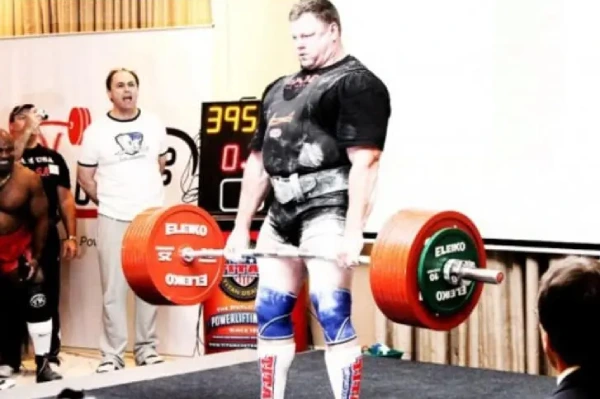
If you’ve ever watched a powerlifting meet or scrolled through Olympic weightlifting clips, you’ve probably noticed lifters wearing either knee-high socks or thick neoprene sleeves around their knees. Both look like protective gear—but they serve very different purposes. Confusing the two can leave you underprepared for training or worse, in violation of competition rules.
This guide breaks down deadlift socks vs. knee sleeves, explains what each actually does, and shows you when (and why) to wear them.
Quick Answer: Comparison
| Gear | Primary Function | Best For | Required in Competition? | When Not to Wear |
|---|---|---|---|---|
| Deadlift Socks | Protect shins from barbell knurling; reduce friction; hygiene. | Powerlifting deadlifts, barbell pulls, CrossFit rope climbs. | Yes, in powerlifting deadlifts (IPF/USAPL: must cover shins). | If you don’t pull from the floor, or if the bar never scrapes shins. |
| Knee Sleeves | Warmth, compression, joint support. | Squats, high-volume lower body work, and Olympic weightlifting. | Allowed (thickness/material regulated), but not required. | If knees are healthy and you want max mobility/cooler feel. |
For a refresher on what deadlift socks are and why lifters use them, check out our post: What Are Deadlift Socks & Why Powerlifters Use Them.
What Knee Sleeves Actually Do
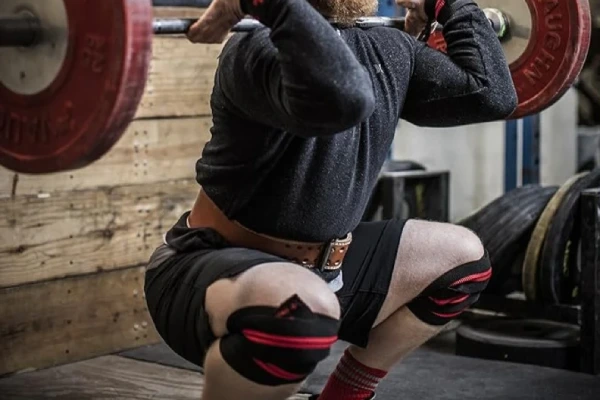
Knee sleeves are most commonly made of 5–7mm thick neoprene. Their role is not shin protection, but joint warmth and compression. That compression can improve proprioception (your sense of joint position), keep knees warm between sets, and provide a small feeling of stability during squats or heavy pulls.
- Benefits: Warmer joints, reduced soreness, psychological “tightness.”
- Limitations: They don’t stop shin scraping; they don’t add pounds to your deadlift directly.
- Best use cases: Squats, high-volume Olympic lifts, general lower-body training days.
What Deadlift Socks Actually Do
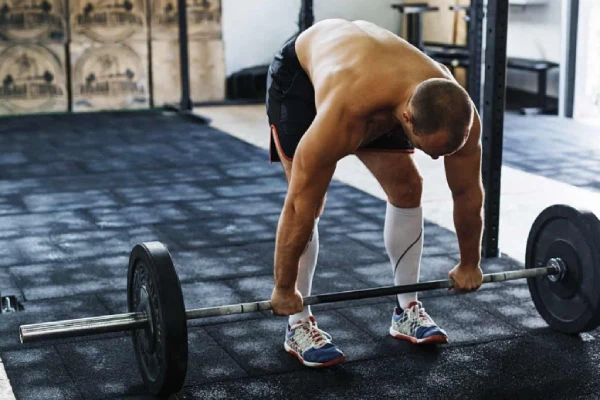
Deadlift socks are tall, knee-high socks crafted from durable, tightly woven fabric designed to handle repeated barbell contact. Their role goes beyond looking the part—they serve three essential purposes:
- Shin protection: The socks act as a barrier between your skin and the barbell’s aggressive knurling. This helps prevent cuts, scrapes, and bruising when the bar travels close to your legs.
- Reduced friction for better bar path: The smooth fabric surface allows the bar to glide up your shins without catching, making it easier to maintain a tight, efficient pull.
- Competition compliance: In federations like the IPF and USAPL, knee-high deadlift socks are mandatory during deadlift attempts to keep equipment blood-free and hygienic.
👉 Curious how deadlift socks differ from everyday gym socks? Check out: Deadlift Socks vs Regular Gym Socks: Key Differences Explained.
Sport-by-Sport Reality Check
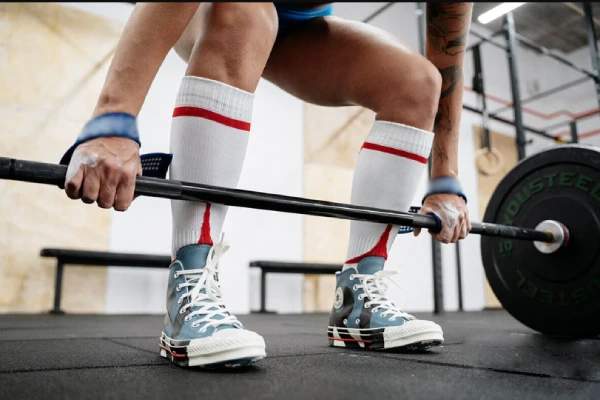
Powerlifting:
Deadlift socks are non-negotiable in sanctioned meets. They must cover your shins during the pull to meet federation hygiene rules. Knee sleeves are allowed, but they’re optional for deadlifts and mostly benefit squats. On the deadlift platform, socks are the priority.
Olympic Weightlifting:
Knee sleeves are everywhere in weightlifting gyms—lifters rely on them for squats, pulls, and keeping knees warm between attempts. Socks can provide shin protection during heavy pulls, but they aren’t a requirement and are less common on stage.
CrossFit & Functional Fitness:
Both pieces of gear earn their place. Socks protect your shins in rope climbs, box jumps, and barbell pulls. Sleeves support your knees through high-rep squats, lunges, and plyometrics. Many CrossFit athletes rotate between both depending on the workout of the day.
General Strength Training:
Think of it as problem-solving gear. If the bar is tearing up your shins, grab deadlift socks. If your knees feel sore or stiff, sleeves make more sense. For everyday gym training, you only need what addresses your specific weak spot.
Will Either Make Your Deadlift Stronger?
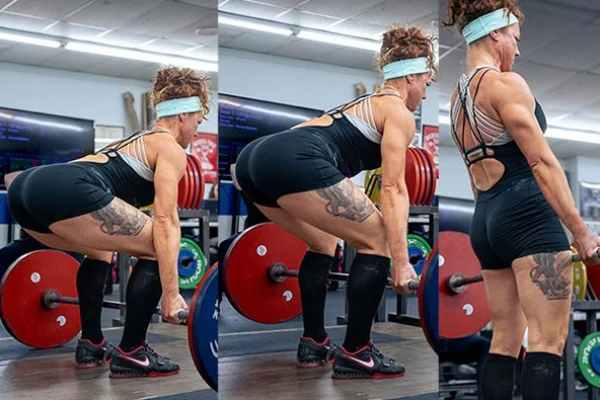
Let’s clear this up right away: neither deadlift socks nor knee sleeves will magically add kilos to your max. They’re not performance enhancers in the sense of directly boosting strength. Instead, they work by removing distractions and keeping you comfortable—so you can focus on moving weight with better mechanics.
- Deadlift socks: Their biggest benefit is psychological and technical. By protecting your shins from scrapes, they give you gain the confidence to keep the bar close throughout the pull. A tighter bar path = more efficient leverage = stronger lifts in practice.
- Knee sleeves: Their advantage is comfort and endurance. The warmth and compression around your knees reduce stiffness and soreness, especially in higher-volume blocks. That comfort may help you grind through extra sets or reps, which ultimately supports strength progression.
In short, these pieces of gear don’t cheat gravity—they help you train harder, longer, and with better form. That’s where the real performance payoff comes from.
How to Decide in 10 Seconds
- Competing in powerlifting?
→ Deadlift socks are mandatory. Knee sleeves are optional. - Shins always scraped?
→ Prioritize deadlift socks to protect your skin and keep the bar close. - Knees feel stiff or achy?
→ Go for knee sleeves to add warmth and compression. - Training focus is mostly squats?
→ Start with knee sleeves; they’ll give more value here. - Doing both heavy squats and pulls?
→ Use both—they target different problems and complement each other.
FAQs
Is it better to deadlift in socks?
Deadlifting in socks can help you feel more grounded by reducing the sole height between your feet and the floor. This creates a more stable pulling position. In competition, though, you’ll still need knee-high deadlift socks for shin protection and hygiene.
What is special about deadlift socks?
Deadlift socks are designed to cover the shins with durable, smooth fabric. They prevent cuts from barbell knurling, reduce friction so the bar can stay close, and are required by most powerlifting federations for hygiene reasons.
Do knee sleeves increase deadlifts?
Knee sleeves don’t directly increase your deadlift max. Their compression mainly warms the joint and adds stability, which can improve comfort during volume work. Any strength benefit is indirect, unlike in squats, where sleeves can play a bigger role.
How to avoid scraping shins on deadlifts?
To avoid shin scraping, keep the bar close but use proper hip positioning so the bar tracks smoothly. Wearing deadlift socks adds a protective layer and reduces friction without forcing you to change good bar path mechanics.
Do knee sleeves make you lift more?
Knee sleeves don’t make you stronger on their own. They support the knee joint with warmth and compression, which can help lifters feel more stable and train harder. The performance boost is indirect, not a guaranteed increase in max lifts.
Conclusion
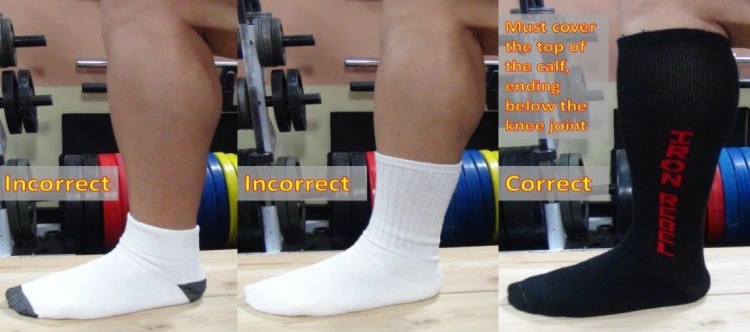
Deadlift socks and knee sleeves serve very different purposes. Socks protect your shins, keep the bar path tight, and meet competition rules. Sleeves support your knees with warmth and compression, making training more comfortable. Powerlifters need socks; athletes chasing joint health may want sleeves too. Many lifters eventually use both as complementary tools.
For gyms, teams, or distributors looking to equip multiple athletes, Max Hosiery offers bulk orders of competition-ready Deadlift Socks—built for durability, comfort, and compliance. 👉 Contact us today to discuss wholesale pricing and custom solutions.
